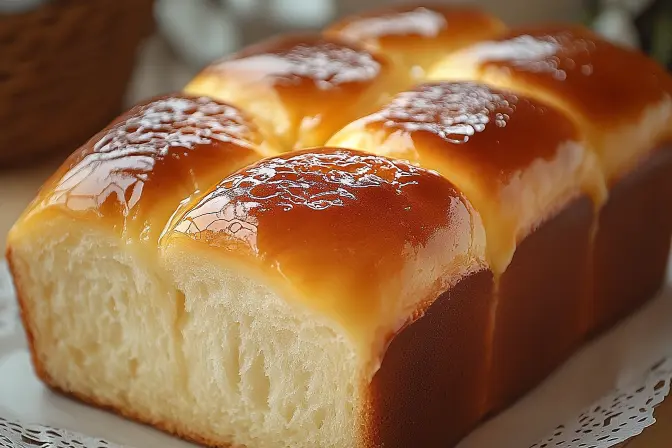Description
This Easy Sweet Condensed Milk Bread is a delightful homemade bread that boasts a soft, tender crumb and a subtle sweetness from the addition of sweetened condensed milk. It’s a pull-apart style loaf, perfect for sharing, and incredibly easy to make even for beginner bakers. Imagine a cloud-like texture, a hint of comforting sweetness, and the satisfying aroma of freshly baked bread filling your kitchen – that’s what this recipe delivers. The condensed milk not only adds sweetness but also contributes to the bread’s incredibly moist and melt-in-your-mouth quality. This bread is equally enjoyable on its own, slathered with butter or jam, or even used as a base for delicious sandwiches. It’s a versatile and crowd-pleasing recipe that will quickly become a family favorite. This delightful bread combines the simplicity of classic baking with the unique sweetness of condensed milk. The result is a soft, fluffy loaf with a delicate flavor that’s simply irresistible. Each bite offers a perfect balance of sweetness and a satisfying chew, making it ideal for breakfast, brunch, or an afternoon treat.
Why you will love this recipe
You’ll absolutely adore this Sweet Condensed Milk Bread because it’s incredibly easy to make, requiring minimal effort and readily available ingredients. The sweetened condensed milk imparts a subtle, delightful sweetness that elevates the bread beyond the ordinary, making it a truly special treat. The texture is unbelievably soft and fluffy, practically melting in your mouth with every bite. This bread is versatile enough to be enjoyed on its own, toasted with butter, or used to create delicious sandwiches or French toast. Its irresistible aroma will fill your kitchen with warmth and comfort, making it a perfect addition to any gathering or a simple indulgence on a quiet afternoon. Plus, the recipe is easily adaptable – you can add your favorite flavors like chocolate chips, nuts, or spices to customize it to your preferences. It is a simple and satisfying recipe. It tastes amazing!
Ingredients:
- 3 1/2 cups (440 g) all-purpose flour, plus extra for dusting
- 1 packet (2 1/4 teaspoons) instant yeast
- 1/4 cup (50 g) granulated sugar
- 1/2 teaspoon salt
- 1/2 cup (120 ml) warm milk (about 110°F/43°C)
- 1/4 cup (60 ml) sweetened condensed milk
- 1/4 cup (60 g) unsalted butter, softened
- 1 large egg
- 1/4 cup (60 ml) warm water
For the egg wash:
- 1 large egg, beaten
- 1 tablespoon water
Preparation:
Step 1: Prepare the Dough. In a large mixing bowl, whisk together the all-purpose flour, instant yeast, granulated sugar, and salt. Ensure that the dry ingredients are thoroughly combined for even distribution, which will contribute to the bread’s consistent texture and rise. A good whisking at this stage will prevent pockets of yeast or salt from concentrating in one area, ensuring a more balanced flavor and even fermentation.
Step 2: Combine Wet Ingredients. In a separate bowl, whisk together the warm milk (aim for around 110°F/43°C – this temperature is crucial for activating the yeast without killing it), sweetened condensed milk, softened unsalted butter (ensuring it’s properly softened allows it to incorporate smoothly into the dough), one large egg, and the warm water. The warm milk aids in dissolving the condensed milk and softening the butter, creating a homogeneous mixture that will easily incorporate into the dry ingredients.
Step 3: Form the Dough. Gradually add the wet ingredients to the dry ingredients, mixing with a spoon or your hands until a sticky dough forms. Start by adding the wet ingredients in small increments to avoid over-wetting the dough. The dough will be slightly sticky at this stage, which is normal. Avoid adding excessive amounts of flour to compensate, as this can result in a dry, dense bread.
Step 4: Knead the Dough. Transfer the dough to a lightly floured surface and knead for 8–10 minutes, or until it becomes smooth and elastic. Kneading is a crucial step in developing the gluten in the flour, which gives the bread its structure and chewiness. If you prefer, you can use a stand mixer with a dough hook on medium speed for 5–6 minutes, which will save you some time and effort. The dough should become less sticky and more pliable as you knead it.
Step 5: First Rise. Form the dough into a ball and place it in a greased bowl. Cover with a damp cloth or plastic wrap and let it rise in a warm place for 1–1.5 hours, or until it doubles in size. This first rise is essential for the yeast to work its magic, producing carbon dioxide that makes the dough light and airy. The warm environment encourages the yeast to ferment, leading to a good rise.
Step 6: Shape the Bread. Once risen, gently punch down the dough to release the air that has accumulated during the first rise. This step ensures that the dough’s internal structure is evened out. Then, divide the dough into 8–10 equal pieces and shape each piece into a ball. Arrange them in a greased 9-inch (23 cm) round or square baking pan, slightly touching each other. This arrangement creates a visually appealing pull-apart loaf that’s perfect for sharing.
Step 7: Second Rise. Cover the pan with a damp cloth or plastic wrap and let the dough rise again for 30–40 minutes, or until puffy. This second rise allows the dough to further relax and become even lighter before baking, resulting in a softer and more tender final product.
Step 8: Prepare for Baking. Preheat your oven to 350°F (175°C). Preheat your oven about 10 minutes before baking.
Step 9: Egg Wash and Bake. Brush the tops of the dough with the beaten egg wash for a shiny, golden crust. The egg wash adds a beautiful sheen and richness to the bread’s surface. Bake in the preheated oven for 20–25 minutes, or until the bread is golden brown and sounds hollow when tapped. Keep a close eye on the bread during baking to prevent it from burning.
Step 10: Cool and Serve. Let the bread cool in the pan for 10 minutes before transferring it to a wire rack to cool completely. Cooling the bread slightly in the pan helps it to retain its shape. Serve warm or at room temperature, plain or with your favorite spread such as butter, jam, or cream cheese.
COOKING Rating:
Easy to medium
Serving Suggestions:
- Enjoy it warm, sliced, and served with a pat of butter.
- Toast slices and spread with jam, honey, or Nutella.
- Use it to make delicious sandwiches.
- Serve alongside a cup of coffee or tea for a comforting snack.
- Make French toast with it for a decadent breakfast.
- Serve it with a scoop of ice cream for a delightful dessert.
Tips:
- Ensure your yeast is fresh by testing it in warm water with a pinch of sugar – it should foam up within 5-10 minutes.
- Don’t over-knead the dough, as this can result in a tough bread.
- If the dough is too sticky to handle, lightly flour your hands and the work surface.
- For a richer flavor, use brown butter instead of softened butter in the dough.
- Adjust the sweetness by adding or reducing the amount of granulated sugar.
- If the bread starts to brown too quickly in the oven, tent it with foil.
- Store leftover bread in an airtight container to keep it fresh for longer.
- For best results, measure your ingredients accurately using a kitchen scale.
- Avoid opening the oven door frequently during baking to prevent temperature fluctuations.
Prep Time: 25 minutes
Cook Time: 20-25 minutes
Total Time: 2 hours 30 mins
Nutritional Information: (approximate, per serving)
- Calories: 250 kcal
- Protein: 6 g
- Sodium: 200 mg
Conclusion
This Easy Sweet Condensed Milk Bread recipe is a delightful way to bring the joy of homemade baking into your kitchen. With its soft, fluffy texture and subtle sweetness, it’s a versatile treat that can be enjoyed in countless ways. Whether you’re a seasoned baker or just starting out, this recipe is simple enough to master and impressive enough to share with friends and family. So gather your ingredients, preheat your oven, and get ready to enjoy the warm, comforting aroma of freshly baked bread. This is a recipe that’s sure to become a cherished favorite for years to come!
Questions and Answers:
Q1: Can I use a different type of flour for this recipe?
A: While all-purpose flour is recommended for its versatility and gluten content, you can experiment with bread flour for a slightly chewier texture. However, bread flour may require a bit more liquid, so adjust accordingly. Whole wheat flour can also be used, but it will result in a denser and slightly drier bread. I suggest substituting no more than half of the all-purpose flour with whole wheat flour. Be sure to monitor the dough’s hydration and add more liquid if necessary to achieve the desired consistency.
Q2: How can I tell if my yeast is still active?
A: To test your yeast’s activity, dissolve it in warm water with a pinch of sugar. Let it sit for about 5-10 minutes. If the mixture becomes foamy and bubbly, your yeast is active and ready to use. If it doesn’t foam, the yeast is likely inactive and should be discarded, otherwise your dough may not rise properly, resulting in a flat and dense bread. Using active yeast is crucial for achieving the desired light and airy texture of the Sweet Condensed Milk Bread.
Q3: Can I make this recipe without a stand mixer?
A: Absolutely! While a stand mixer can simplify the kneading process, it’s not essential. You can easily knead the dough by hand on a lightly floured surface for about 8-10 minutes, until it becomes smooth and elastic. Hand kneading requires a bit more effort, but it’s a great way to connect with the dough and feel its transformation. Just ensure you use proper kneading technique to develop the gluten effectively.
Q4: How do I store the leftover bread to keep it fresh?
A: To keep your Sweet Condensed Milk Bread fresh, store it in an airtight container at room temperature. It will typically stay soft and enjoyable for up to 3 days. For longer storage, you can freeze the bread for up to 3 months. Wrap it tightly in plastic wrap and then in a freezer bag to prevent freezer burn. When ready to enjoy, thaw the bread at room temperature or warm it in the oven for a few minutes to restore its soft texture.
Q5: Can I add any flavors or toppings to this bread?
A: Absolutely! This recipe is highly versatile and can be customized to your liking. You can add chocolate chips, raisins, nuts, or shredded coconut to the dough for a sweet twist. For a savory option, try adding herbs like rosemary or thyme, or incorporating shredded cheese into the dough. You can also sprinkle the top of the bread with sesame seeds, poppy seeds, or a streusel topping before baking for added flavor and texture. Feel free to get creative and experiment with different combinations to create your own signature version of this delightful bread!




